Lincoln Navigator: Automatic Transmission - 10-Speed Automatic Transmission – 10R80 / Leakage Inspection. Diagnosis and Testing
Lincoln Navigator 2018-2025 Workshop Manual / Automatic Transmission / Automatic Transmission - 10-Speed Automatic Transmission – 10R80 / Leakage Inspection. Diagnosis and Testing
Leak Check Test
-
With the vehicle in NEUTRAL, position it on a hoist.
REFER to: Jacking and Lifting (100-02 Jacking and Lifting, Description and Operation).
-
Inspect the gaskets and sealing areas for evidence of leakage.
-
Trace the transmission fluid leak to the highest point.
-
Clean the area of the suspected leak.
-
Lower the vehicle.
-
Remove the transmission fluid fill plug or fluid level indicator.
-
Add leak detection dye to the transmission fluid. Use 1 fl oz
(30 ml) of dye solution for every 4 qt (3.8 L) of transmission fluid.
-
With the transmission fluid at normal operating temperature,
road test the vehicle for at least 1 mile with at least 1 application of
the TCC .
-
With the vehicle in NEUTRAL, position it on a hoist.
REFER to: Jacking and Lifting (100-02 Jacking and Lifting, Description and Operation).
-
If the source of the leak is obvious, repair as required.
-
After the repair, clean the affected area.
Leakage From Torque Converter Housing
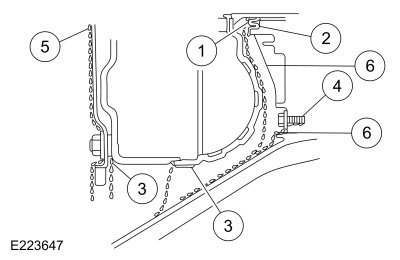
-
Leaks from the torque converter housing can originate from
several locations. The paths which the transmission fluid takes to reach
the bottom of the torque converter housing is shown in the
illustration. The following 6 steps correspond with the numbers in the
illustration.
-
Transmission fluid leaking by the converter hub seal lip
will tend to move along the drive hub and onto the back of the torque
converter. Except in the case of a total seal failure, transmission
fluid leakage by the lip of the seal will be deposited on the inside of
the torque converter housing only, near the outside diameter of the
housing.
-
Transmission fluid leakage by the outside diameter of the
torque converter impeller hub seal and the case will follow the same
path that leaks by the inside diameter of the converter hub seal follow.
-
Transmission fluid leakage from the converter cover weld or
the converter-to-flexplate stud weld will appear at the outside diameter
of the torque converter on the back face of the flexplate and in the
converter housing only near the flexplate. If a converter-to-flexplate
lug, lug weld or converter cover weld leak is suspected, remove the
converter and pressure check.
-
Transmission fluid leakage from the bolts inside the
converter housing will flow down the back of the torque converter
housing. Leakage may be from loose or missing bolts.
-
Engine oil leaks from the rear main oil seal.
-
Transmission fluid leak from front support cover and seal assembly.
-
Transmission fluid leaking by the converter hub seal lip
will tend to move along the drive hub and onto the back of the torque
converter. Except in the case of a total seal failure, transmission
fluid leakage by the lip of the seal will be deposited on the inside of
the torque converter housing only, near the outside diameter of the
housing.
-
Remove the torque converter.
-
Using a black light, observe the torque converter housing.
Inspect for evidence of dye from the pump bolts, front support cover and
seal assembly, and torque converter hub seal. Repair as required.
-
If the source of the leak is not evident, continue with this procedure to leak test the torque converter.
-
Place the torque converter in an arbor press. Support the torque converter on the mounting pads.
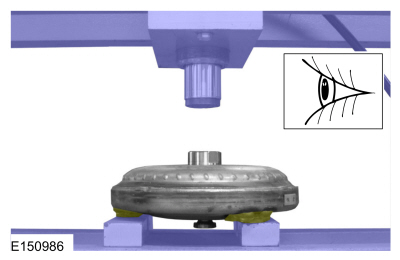
-
Install the torque converter leak tester (307-421A) into the torque converter hub.
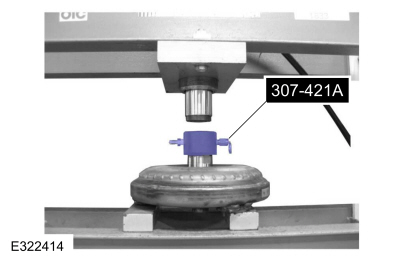
-
Secure the press. Apply enough force from the press to seal the
torque converter leak tester (307-421A) into the torque converter hub.
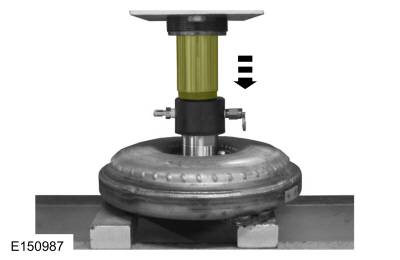
-
Connect a compressed air supply to the torque converter leak tester (307-421A).
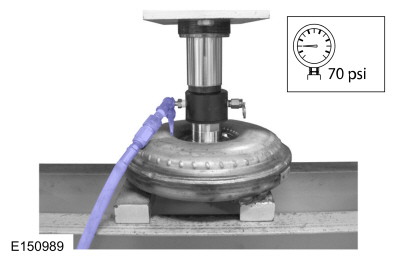
-
Apply air pressure to the torque converter and inspect for leaks
at the torque converter hub welds and seams. Use a soap bubble solution
around those areas to aid in diagnosis. If any leaks are present,
install a new torque converter.
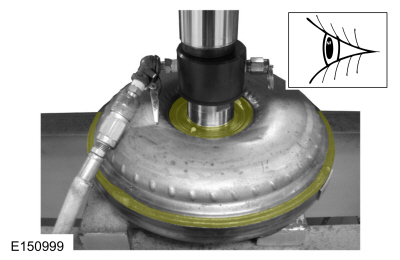
-
Inspect for leaks at the stud or mounting pad and balance weight
welds. Use a soap bubble solution around those areas to aid in
diagnosis. If any leaks are present, install a new torque converter.
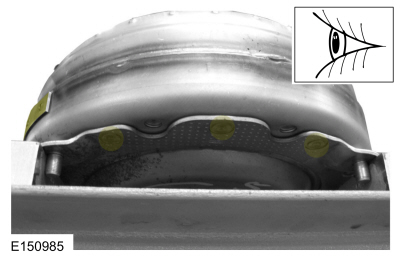
-
After leaks are repaired, clean the remaining transmission fluid dye from serviced areas.
 Road Testing Vehicle. Diagnosis and Testing
Road Testing Vehicle. Diagnosis and Testing
Shift Point Road Test
NOTE:
Always drive the vehicle in a safe manner according to driving conditions and obey all traffic laws.
Upshift Gear Sequence
At times the 10-speed transmission may skip gears when the vehicle starts from a complete stop...
 Parameter Identification (PID) Chart. Diagnosis and Testing
Parameter Identification (PID) Chart. Diagnosis and Testing
Diagnostic PID Chart
PID Acronym
PID Name
Description
APP
Accelerator Pedal Position
Accelerator pedal position percentage
APP1_[APP_D]
Accelerator Pedal Position D
Accelerator pedal position sensor 1 percentage
AT_NEU_DRV_STA
Auto Trans Neutral Drive..
Other information:
Lincoln Navigator 2018-2025 Workshop Manual: Transmission Strategy Download. General Procedures
Programming This procedure should be performed when a new transmission or main control valve body is installed in the vehicle. 13 - digit solenoid body strategy 12 - digit solenoid body identification If a new main control was installed, record the 13-digit solenoid body strategy from the replacement solenoid body tag provided with the main ..
Lincoln Navigator 2018-2025 Workshop Manual: Valve Train Analysis. General Procedures
Valve Train Analysis - Engine Off, Valve Cover Removed NOTE: The following component inspections are used to diagnose valve train concerns. Check for damaged or severely worn parts and correct assembly. Valve Train Analysis - Camshaft Lobe Lift Remove the spark plugs. For additional information, refer to: Spark Plugs (303-07 Engine Ignition - 3.5L E..
Categories
- Manuals Home
- 4th Gen Lincoln Navigator Service Manual (2018 - 2025)
- Rear View Mirrors - System Operation and Component Description. Description and Operation
- Head Up Display (HUD) Module Calibration. General Procedures
- Transmission Fluid Level Check. General Procedures
- Vehicle Dynamics Control Module (VDM). Removal and Installation
- Power Running Board (PRB). Diagnosis and Testing
Front Stabilizer Bar Link. Removal and Installation
Removal
NOTICE: Suspension fasteners are critical parts that affect the performance of vital components and systems. Failure of these fasteners may result in major service expense. Use the same or equivalent parts if replacement is necessary. Do not use a replacement part of lesser quality or substitute design. Tighten fasteners as specified.
NOTE: Removal steps in this procedure may contain installation details.
With the vehicle in NEUTRAL, position it on a hoist.Refer to: Jacking and Lifting (100-02 Jacking and Lifting, Description and Operation).
NOTICE: Do not use power tools to remove or install the stabilizer bar
Copyright © 2025 www.linavigator4.com
